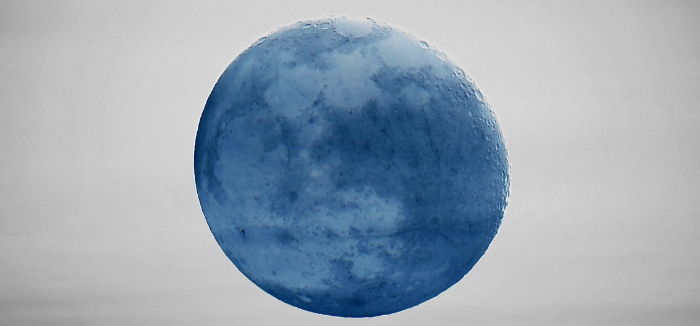| 2023 Aug: A Super-Blue-Moon for Summer (2023-7-31) ⬅︎ |
 |
On August 30 we will be experiencing a full moon known as a blue moon. Will it be changing colors to help celebrate this special day? No... it will not look any different from a typical full moon.
So what is a blue moon?
Before answering this, it's good to know a little bit about the orbital mechanics of the Moon, Earth and Sun. First of
all, the Moon orbits the Earth in precisely 27.32 days. This is known as a sidereal month because it is
based on the alignment between Earth, Moon and the background stars.
Because the Earth is also moving as it orbits the Sun in a year, the Moon has to orbit Earth another 2.21 days to
return to the
same alignment with the Sun. This totals 29.53 days and is known as a synodic month. The
lunar cycle that goes from New Moon, First Quarter, Full Moon, Last Quarter and back to New Moon is based on
this.
And now time for a children's rhyme:
Thirty days hath September,
April, June, and November,
All the rest have thirty-one,
But February's twenty-eight,
The leap year, which comes once in four,
Gives February one day more.
Let's put it all together... since it takes 29.53 days to go from one
full moon to the next, a month can actually have two full moons if the first one occurs on the first
day of the month. This is most likely in months with 31 days but it can also
happen in months with 30 days if the first full moon happens early enough on the first day. It can't happen in
February.
Let's return to the question... what is a blue moon? It is the name for the 2nd
full moon in a month. On average, these happen about every 32 months -- once in a blue moon. Make sense?
The August 30 blue moon will also be a supermoon making the occurrence even rarer.
What is a supermoon? Since the Moon's orbit around the Earth is elliptical, the precise distance between Earth and Moon is continual changing from 221,500 mi at its closest, known as perigee, to 252,700 mi at its furthest, known as apogee. If the perigee occurs at the time of a full moon, it is known as a supermoon and the Moon will appear slightly larger.
There are usually three or four supermoons each year so it is not a rare event but the combination of a blue moon and a supermoon is much rarer, happening every 10 years or so.
So our super-blue-moon on August 30 is special indeed! |
| |



